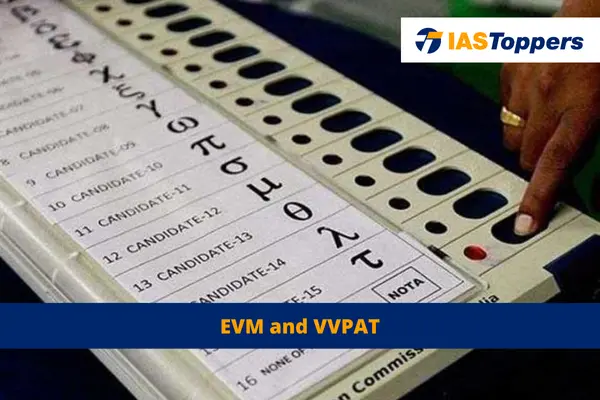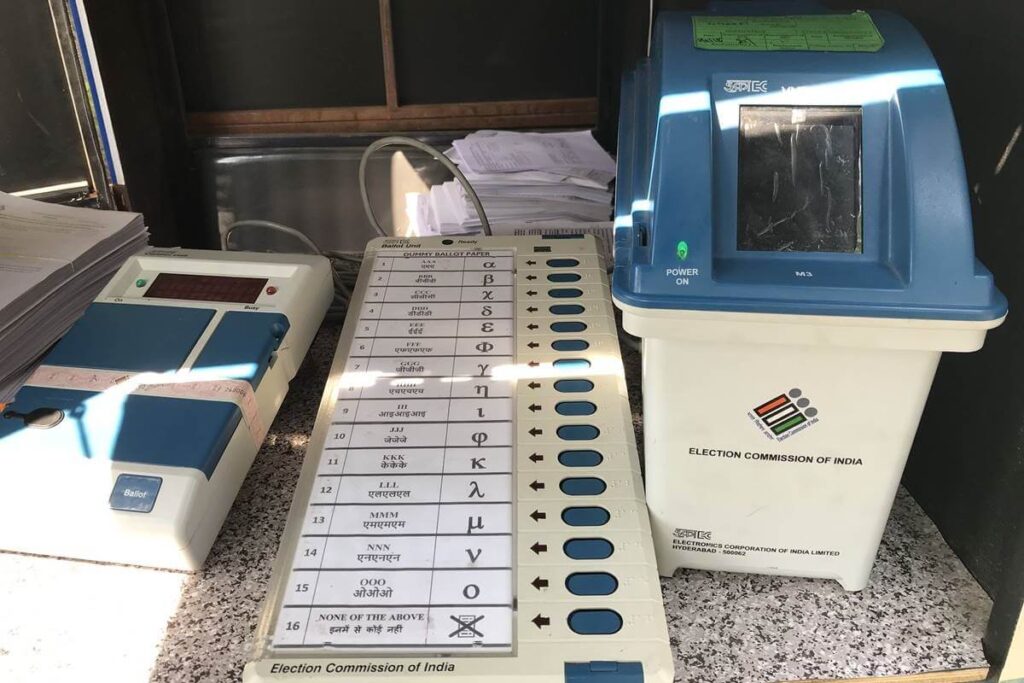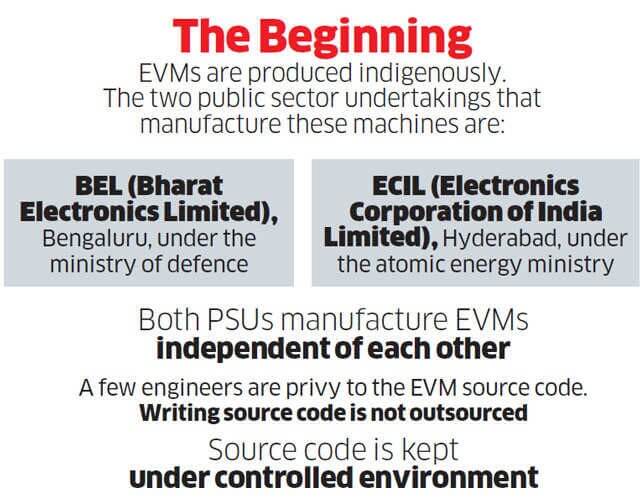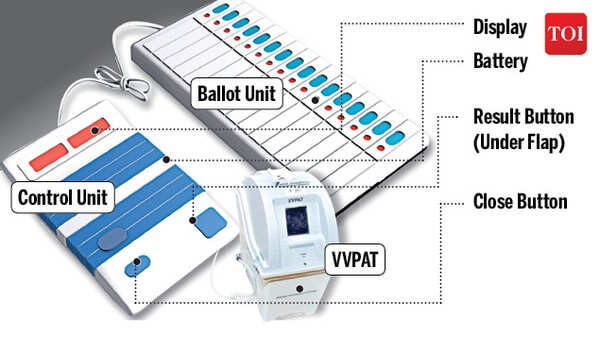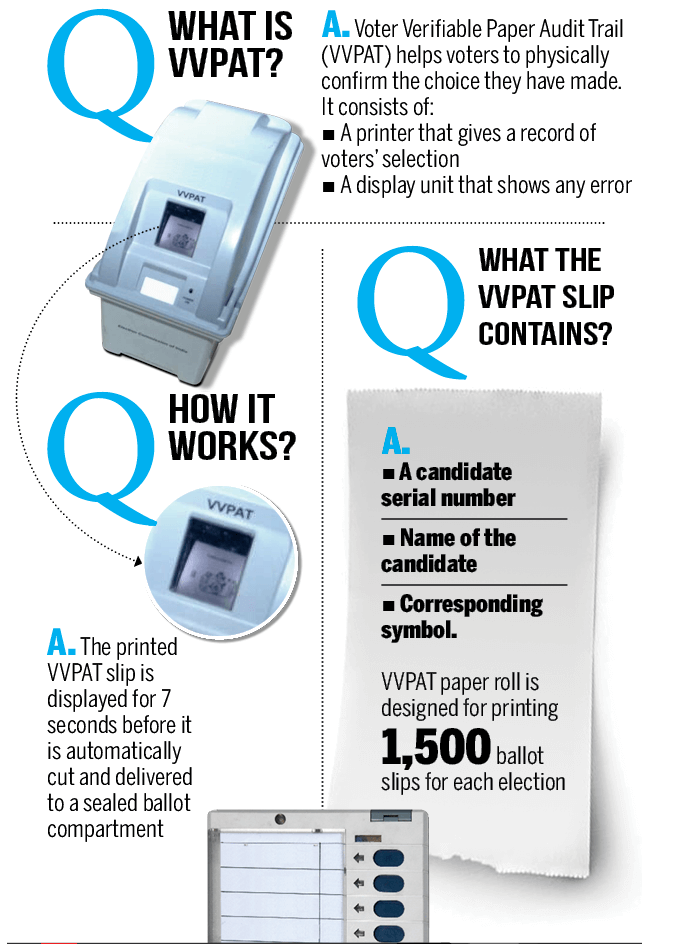The Electronic Voting Machine (EVM) is an easy-to-use device that speeds up the voting and counting process in Indian elections, eliminating the risk of invalid votes. The Voter Verifiable Paper Audit Trail (VVPAT) connected to EVMs provides transparency by giving voters a printed confirmation of their vote. However, concerns have been raised regarding EVM and VVPAT malfunctions and potential security vulnerabilities, which could undermine the integrity of the electoral process. In this article, you will know about meaning and definition of Electronic Voting Machines, how it works, advantages, disadvantages and what is Voter verifiable paper audit trail (VVPAT). To explore more interesting UPSC Polity topics of GS Paper -2 like Electronic Voting Machines, check out other articles and IAS Notes of IASToppers.
Table of Content
- What is Electronic Voting Machine (EVM)?
- History and Origin of EVM in India
- How does EVM work?
- Compliant against EVM
- Advantages of EVMs
- Disadvantages of EVMs
- What is Voter Verifiable Paper Audit Trail (VVPAT)?
- Challenges, Issues and Concerns With VVPAT
- Conclusion
- FAQs on Electronic Voting Machines and Voter Verifiable Paper Audit Trail
What is Electronic Voting Machine (EVM)?
- Electronic Voting Machine (EVM) is an electronic device for recording votes.
History and Origin of EVM in India
- The Electronic Voting Machine (EVM) was initially thought up by the Election Commission in 1977.
- The task of creating EVM was given to Electronics Corporation of India Ltd. (ECIL) in Hyderabad. Bharat Electronic Ltd. (BEL) in Bangalore also joined hands with ECIL.
- The first use of EVMs happened in Kerala’s general election in May 1982.
- However, the lack of specific laws governing EVM usage caused the Supreme Court to invalidate the election results.
- In response, in 1989, the Representation of the People Act, 1951, was amended by inserting Section 61Ato allow for EVM usage in elections.
- However, it was only in 1998 that there was widespread agreement on their use.
- The EVMs were initially used in 25 assembly constituencies in Madhya Pradesh, Rajasthan, and Delhi.
- The usage gradually increased, reaching 45 parliamentary constituencies in 1999, then expanding to 45 assembly constituencies in Haryana in February 2000.
- By the state assembly elections in May 2001, EVMs were used in all assembly constituencies in Tamil Nadu, Kerala, Puducherry, and West Bengal.
- Since then, EVMs became a standard feature in all state assembly elections.
How does EVM work?
- The EVM consists of two components that are connected by a cable:
- Control Unit (CU) managed by a polling officer and
- Balloting Unit (BU) found within the voting booth.
- The polling officer starts the voting process by pressing the control unit’s ballot button.
- Then, voters can cast their vote by pressing the blue button next to the preferred candidate’s name and symbol on the balloting unit.
- For visually impaired voters, there is Braille signage with digits 1 to 16 embossed next to the candidates’ voting buttons.
- EVMs function on ordinary batteries, eliminating the need for electricity. They are designed to register a maximum of 2,000 votes.
- If an EVM fails, it is replaced, but the votes recorded up to that point remain secure in the control unit’s memory. The control unit also retains the results until manually cleared.
- Polling stations strictly prohibit changing the paper roll.
- The EVM displays candidates’ names in alphabetical order, prioritizing candidates from national political parties, followed by those from state-registered parties.
- EVM’s are given to the polling station in two stages of randomization by the EVM tracking software produced by the commission.
Compliant against EVM
- If a voter challenges the accuracy of the cast vote under Rule 49MA of the Conduct of Elections Rules, 1961, the presiding officer may request a written declaration from the voter.
- If the voter gives the written declaration, the presiding officer can permit the elector to record a test vote in his presence and see the paper slip is generated.
- If the complaint is true, the presiding officer will immediately contact the returning officer and halt further voting on that machine.
Advantages of EVMs
- Streamlined Voting Process: Electronic Voting Machines (EVMs) have revolutionized the voting procedure by removing the need for marking and depositing a physical ballot. Instead, voters simply press a button to cast their vote for their preferred candidate.
- Lots of Safety features: Any kind of Radio Frequency transmission or reception or wireless communication is not possible through EVM. It has One Time Programmable (OTP) chip and has real time clock for time and date stamping key press
- Elimination of Invalid Votes: With the EVM system, the chances of invalid votes are nullified, which was a persistent issue in the traditional paper ballot system.
- Swift Counting and Result Declaration: The EVM system allows for a rapid counting process, meaning results can be declared within hours rather than days.
- Cost-efficient: EVMs remove the necessity for producing millions of ballot papers, saving costs associated with paper, printing, transport, storage, and distribution.
- Assured Voting Confirmation: The EVM provides both audio and visual confirmations to ensure voters that their vote has been accurately recorded.
- Vote Tampering Prevention: An EVM’s system is sealed and protected. Any attempt to rig votes or modify the machine’s programming would result in damage, hence safeguarding against fraudulent activities. EVMs also restrict 5 votes for every minute.
- Increased Candidate Capacity: A single EVM voting system can host up to 64 candidates in one constituency.
- Time-efficient Voting: The use of EVMs speeds up the voting process, with up to five people able to cast their votes per minute.
- Single Vote Restriction: EVMs allow each voter only one vote. Any subsequent attempts to vote will be disregarded.
- Battery-powered Operation: EVMs are battery-operated, ensuring an uninterrupted voting process even without electricity.
- Long-term Vote Storage: Voting data can be stored within an EVM for up to a decade.
- NOTA Option Availability: EVMs are equipped with a ‘None Of The Above’ (NOTA) button, allowing voters to indicate their dissatisfaction with all the candidates.
Disadvantages of EVMs
Despite skepticism regarding EVM reliability since 2001, the election commission has consistently dismissed any potential for vote manipulation through these machines.
- Understanding the Language on Ballot Units: In every state, the candidates’ names are arranged alphabetically in the native language. For instance, in Maharashtra, candidate names appear in Marathi and in Kannada in Karnataka. So, if a person primarily speak English, he/she might encounter some challenges.
- Accommodation Capacity of the Ballot Units: A single ballot unit has the capacity to hold only 16 candidate names. In situations where there are more candidates, multiple ballot units can be connected. Up to 4 ballot units can be linked, enabling a maximum of 64 candidates to be represented from one constituency. If the candidate count surpasses this, the old manual voting method has to be used.
- Vote Recording Capacity of EVMs: EVMs have a limit of capturing 3840 votes. However, this limitation is not generally considered significant as the voter count at any polling station usually falls below this.
- Potential Threats to Vote Security: There exists a risk of the control unit display being hacked or remotely manipulated via wireless communication. There’s a concern that the data on votes could be changed by attaching a memory manipulator integrated circuit (IC) to the memory chip storing the vote data. Infringements could also occur through the replacement of microcontroller/memory chip or motherboard before polling/counting, or by manipulating the source code with a ‘Trojan’. After the closure of polls, there’s the risk of vote stuffing.
- Issues with Electoral Rolls and Voter Identification: Imperfections in electoral rolls and voter identification can lead to large numbers of citizens being denied their voting rights, and can contribute to voting fraud.
- Menace of Booth Capturing & Misuse of Power: Booth capturing is a widespread issue. There have been cases where voters are coerced to vote against their wishes or deterred from voting entirely through intimidation and physical force. The involvement of officials and local administration in manipulating the electoral process is also a concern.
- Privacy Issues and Favoritism: A potential issue with EVMs is that candidates can determine the number of votes they received from individual polling stations. This may cause favoritism or bias against specific areas, especially if a disproportionate number of votes are cast for or against a particular candidate at certain polling stations. However, the Election Commission of India has noted that EVM manufacturers have developed a Totaliser unit that, when connected to multiple balloting units, displays only the overall results from an Assembly or Lok Sabha constituency, not individual polling station results.
What is Voter Verifiable Paper Audit Trail (VVPAT)?
Alt-text: Voter Verifiable Paper Audit Trail (VVPAT)
- The Voter Verifiable Paper Audit Trail (VVPAT) is a separate system linked to the EVM, that allows voters to confirm their vote.
- It was introduced in 2013 to strengthen transparency in EVM based Voting System.
- It acts as printer that has to be attached to each EVM at the polling station.
- After a vote is cast, the VVPAT prints a slip bearing the candidate’s serial number, name, and symbol, which is visible for seven seconds before it automatically drops into a sealed box.
- Thus, Voter can visually confirm choice exercised by him in the ballot unit.
- This slip cannot be taken home by the voter as it remains securely stored in the machine’s box.
- Access to VVPAT machines is restricted to only the polling officers.
Challenges, Issues and Concerns With VVPAT
- Mechanical Failures: There have been multiple instances of VVPAT machine breakdowns since their introduction, causing delays in polling. For instance, during the Karnataka Assembly elections, 4.2% of the deployed VVPAT machines malfunctioned, and the failure rate reached 11.6% during by-elections in several constituencies.
- Machine Sensitivity: The Election Commission of India (ECI) has noted that these machines are highly sensitive to extreme weather conditions and light exposure, increasing their vulnerability to technical glitches.
- Training Gap: Many issues have arisen due to inadequate training of election staff. The solution might be more intensive training to familiarize staff with the new machines.
- Verification Problems: Studies reveal that many voters don’t check their VVPAT receipts, and those who do often miss discrepancies.
- Audit Difficulty and Expense: Manual VVPAT recounts are labor-intensive, expensive, and potentially unaffordable for many candidates.
- Security Risks: Malicious software can be introduced into the VVPAT system to manipulate the voter’s selections or produce fraudulent ballots.
- Usability Issues: VVPATs may be difficult for poll workers to use. In one case, 9.6% of VVPAT tapes were compromised in some way.
- Privacy Threats: Voting records printed in order can pose a risk to privacy. Also, an attacker could potentially link a voter’s identification to their voting preference, compromising ballot secrecy.
- Effectiveness Doubts: Unless a significant number of voters verify the paper audit before casting a ballot, VVPATs do not effectively check malfunction or fraud.
- Accessibility Issues: Some disabled voters cannot use current VVPAT systems.
- Reliability Worries: Adding a paper trail to DRE machines introduces more opportunities for failures, such as paper jams or running out of ink or paper.
- Implementation Challenges: Adding a VVPAT feature to existing DRE machines can be expensive and difficult due to the need for specialized hardware. In cases where the vendor has not developed a compatible VVPAT component, the jurisdiction may need to purchase an entirely new voting system.
- Declining Public Trust: Recent incidents of faulty VVPAT machines have led to diminishing public trust in the electoral process. In Dr. Subramanian Swamy v Election Commission of India (2013), the Supreme Court declared VVPAT as an “essential requirement of free and fair elections”.
Conclusion
The use of the electronic voting machine in India symbolizes the digital leap in its democratic process. EVMs and VVPATs, despite their flaws, contribute to efficient and secure elections. Yet, maintaining public trust calls for continuous improvement. The Indian government, therefore, should invest more in technological advancements, robust security measures, and widespread voter education to ensure these machines’ effectiveness and transparency in the future.
Ref: Source-1
FAQs (Frequently Asked Question)
When was Electronic Voting Machine introduced for election in India?
The first Electronic Voting Machine (EVM) was used for elections in India in May 1982 during the Kerala general election.
Who examines EVM and VVPAT?
EVM and VVPAT examinations are performed exclusively by engineers from Bharat Electronics Limited and Electronics Corporation of India Limited.
Who invented EVM machine in India?
The concept of the EVM machine in India was initiated by the Election Commission in 1977, with the Electronics Corporation of India Ltd. (ECIL) and Bharat Electronics Ltd. (BEL) involved in its creation.
How to vote in EVM machine?
Voters cast their vote on an EVM by pressing the blue button next to their preferred candidate’s name and symbol on the balloting unit, after the polling officer initiates the voting process.
What is the importance of EVM and VVPAT in voting process?
EVM and VVPAT streamline the voting process, eliminate invalid votes, allow for rapid vote counting, and provide a paper audit trail for vote verification, enhancing the transparency and efficiency of the Indian electoral system.
What is the difference between EVM and Ballot paper?
The primary difference is the medium of voting. While EVMs use electronic means for casting and counting votes, ballot papers involve manual marking, depositing, and counting of votes
What is the full form of nota in EVM machine?
In the context of an EVM, NOTA stands for ‘None Of The Above’, giving voters the option to reject all candidates.
When VVPAT was first used in India?
The VVPAT system was initially implemented by the Election Commission of India in Noksen, Nagaland, during an Assembly Constituency election in September 2013.
How does VVPAT function?
VVPAT works in conjunction with the EVM. When a vote is cast, VVPAT prints a slip bearing the candidate’s serial number, name, and symbol, providing voters with a visual confirmation of their vote, which is then stored securely.


